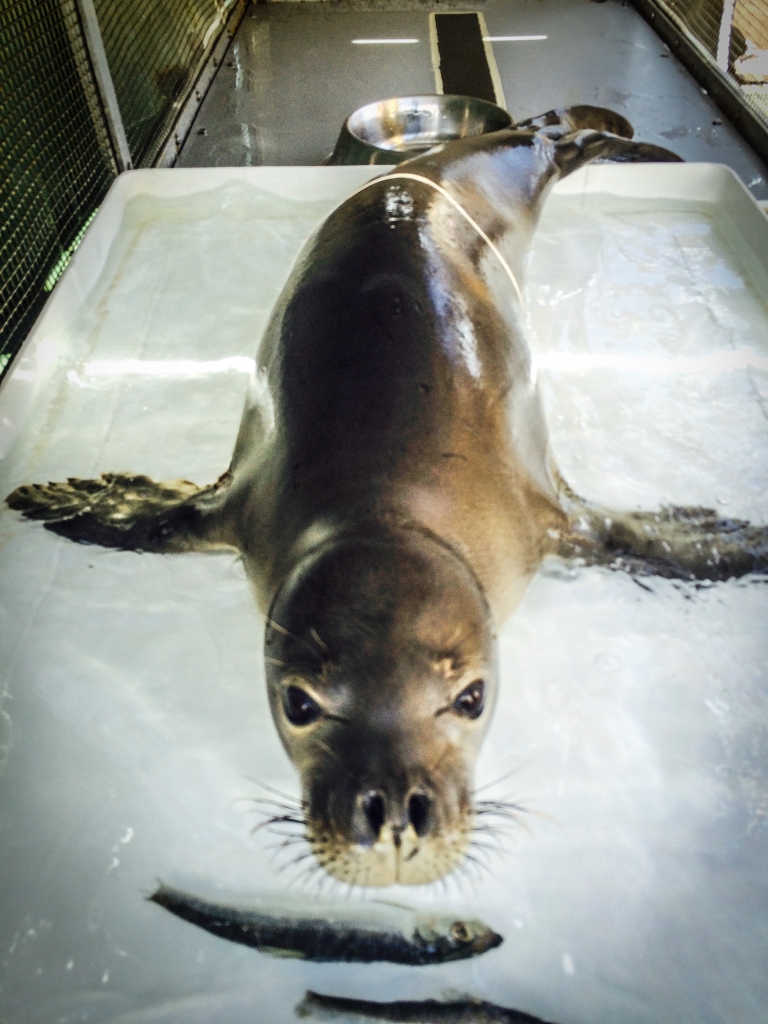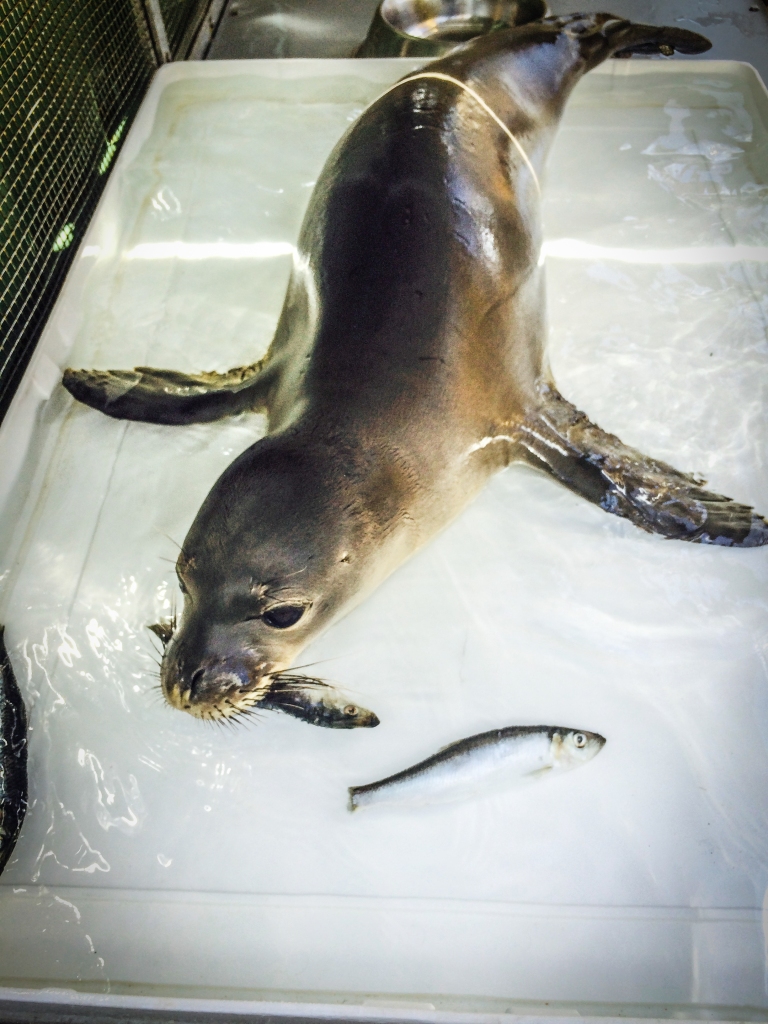The commanding officer, chief bosun and I were aft on Oscar Elton Sette in the early evening when Dr. Michelle, our onboard veterinarian, threw both arms in the air and started an exuberant dance. If it had been an NFL Sunday, I would have thought her team had scored a touchdown. Next to Hawaiian monk seals, football fever seems to rule the conversation on this ship. Fans show their support by stickering their team’s logo on the hard hats we have to wear whenever embarking and disembarking the small boats that take us ashore. But that wasn’t the case here. “She’s eating. She’s eating,” Michelle mouthed, careful not to disrupt our newest passenger’s repast.
Yes, we have another young seal aboard.

One of the more heartwarming things I’ve witnessed on this journey is how much people care.
A few days ago, after we left Honolulu, the field team we’d dropped off at French Frigate Shoals earlier in our voyage reported that they’d found one of the underweight females that had eluded us during our stopover. Good news, right? Yes. And no.
On one hand, the timing wasn’t great. We weren’t scheduled to return to French Frigate Shoals for another two-and-a-half weeks. On the other hand, we happened to be only 24 hours away. But the return would require a change in itinerary and the possible loss of surveying seals at another island, Mokumanamana, also known as Necker, the second island beyond Kaua‘i in the Northwestern Hawaiian Islands.
We could wait and hope the pre-weaner would haul out again, closer to our visit. A well-known adult male who spends most of his life around Oahu once went on a foraging trip that lasted nearly two weeks and total mileage-wise would have equaled a trip from Hawai‘i to San Francisco and halfway home again. Weaners, however, do not travel far and spend a good portion of their days sleeping on the beach on which they were born. So, they’re somewhat easy to find and catch. But this female had been weaned early and was losing weight. The sooner we could get her nourishment the better.
What to do? What to do?
Flexibility is a necessary skill of a Chief Scientist, I’ve learned, and I’ve witnessed Jessie practice flexibility that would rival the most bendy yogi. She trimmed a day here and a day there, and, presto, a monk seal named Ama`ama joined our ship’s passenger list.
The biologist, Shawn, who made the special delivery called, “Take good care of her,” as he drove off. The upper deck was lined with just about every member of the voyage, scientist and crew alike, eager to see the new passenger.
“This was more satisfying than surveying seals at Mokumanamana,” Jessie said after Ama`ama was carried aboard.

When Ama`ama first joined our growing monk seal nursery in the back of the boat, she slept. And slept. The next day, she was more active. She moved in and out of a shallow tub of water. She pushed a dog bowl around with her muzzle. And when she started vocalizing, she about didn’t stop. She also eyed the other two seals on board—Pearl and Hermes—from her pen across the deck. But when it came time for Michelle and her vet tech, Angie, to feed Ama`ama, she would clamp her teeth tight and refuse the feeding tube. She was, you could say, a bit stubborn. (Heads up, Ke Kai Ola;-)
Ama`ama is the Hawaiian word for mullet, a fish, and also the name of the island on which our Ama’ama was born. But when she was giving attitude, I noticed people called her Mullet. She’d been called Mullet a few times already when one evening Michelle and Angie tossed a few whole fish in her pen. Ama`ama played with them, biting them in half, flinging them in the air. But that was it.
Then, suddenly, while Michelle was watching, Ama`ama tossed a chunk of fish into the air and it fell into the back of her throat and disappeared. So, Ama`ama tried it again, and Michelle was performing her victory dance while the bosun, commanding officer, and I watched, wearing smiles on our faces. And so are the myriad of rewards, big and small, of conservation work.

I think you hit on the heart of it, Kim: how much people care. And, from your dedication in time and energy and storytelling about these seals, what pours through so clearly is how much you care. They’re lucky to have you 🙂
LikeLike
Thank you, Jordonna, for your kind comment.
LikeLike
Kim, I am loving your posts on the voyage. Your writing has such an immediacy to it, I feel a little bit like I am looking over your shoulder. Thank you so much for this glimpse into this most special place. I’m back on Kaua’i October 10. I look forward to our next get together.
Marcia >
LikeLike
This is a special place, Marcia. I am grateful to the moon (and back) to be here!
LikeLike
By the end of your post I felt like doing a little dance of my own!
LikeLike
I’m dancing with you, Dana!
LikeLike
Mahalo for the very interesting insight of how NOAA is managing the HMS. This valuable information brings the reality of the HMS precarious existence out in the open for all to see. I can’t wait for the next post and the wonderful pictures.
David Leopold, Volunteer Kauai Monk Seal Conservation Hui.
LikeLike
It’s amazing to witness the work of these great people, David. Truly. Keep up the good work back on Kauai. See you soon.
LikeLike
YES. Caring. Nothing worthwhile happens until people care. Glad to hear that Ama’Ama has taken to the sashimi platter.
LikeLike
Big hearts. We’ve got big hearts doing this work, Sherilyn. And some pretty sharp brains, too. It’s a good team.
LikeLike
Yes, Mokumanaman will be there to survey another time, if not this trip. Good call, Jessie. An obvious one at that.
LikeLike
We might be able to swing by on our return, Mary. We’ll see. We couldn’t survey Nihoa that well, because a southeast swell was running up the only beach there. Mother Nature is teaching us all about flexibility on this trip;-)
LikeLike
So exciting to hear about all the rescues and successes. Keep up the good work everyone. Kim thank you for keeping us up to date.
LikeLike
My pleasure, Dana. I’ve got more updates coming soon!
LikeLike
Loved it! I was hanging on every word, and cheering. Could you hear me?
LikeLike
Yes. Please keep cheering!
LikeLike